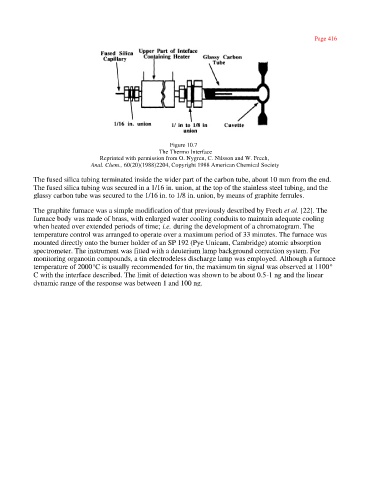Page 433 - Tandem Techniques
P. 433
Page 416
Figure 10.7
The Thermo Interface
Reprinted with permission from O. Nygren, C. Nilsson and W. Frech,
Anal. Chem., 60(20)(1988)2204, Copyright 1988 American Chemical Society
The fused silica tubing terminated inside the wider part of the carbon tube, about 10 mm from the end.
The fused silica tubing was secured in a 1/16 in. union, at the top of the stainless steel tubing, and the
glassy carbon tube was secured to the 1/16 in. to 1/8 in. union, by means of graphite ferrules.
The graphite furnace was a simple modification of that previously described by Frech et al. [22]. The
furnace body was made of brass, with enlarged water cooling conduits to maintain adequate cooling
when heated over extended periods of time; i.e. during the development of a chromatogram. The
temperature control was arranged to operate over a maximum period of 33 minutes. The furnace was
mounted directly onto the burner holder of an SP 192 (Pye Unicam, Cambridge) atomic absorption
spectrometer. The instrument was fitted with a deuterium lamp background correction system. For
monitoring organotin compounds, a tin electrodeless discharge lamp was employed. Although a furnace
temperature of 2000°C is usually recommended for tin, the maximum tin signal was observed at 1100°
C with the interface described. The limit of detection was shown to be about 0.5-1 ng and the linear
dynamic range of the response was between 1 and 100 ng.

